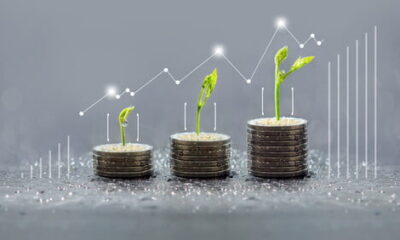Features
Profitable Sustainability
Caroline Rennie describes how working sustainably can make companies more profitable.
 In 2005 H Lee Scott, then CEO of Walmart, announced that his company, one of the world’s largest, was committing to zero waste, sourcing 100 percent of its energy from renewables and selling products that sustain the environment. Within a few years M&S and Tesco were making similarly bold announcements, as were suppliers such as Procter and Gamble, Unilever, Coca-Cola, Pepsi, Kraft and a slew of others.
In 2005 H Lee Scott, then CEO of Walmart, announced that his company, one of the world’s largest, was committing to zero waste, sourcing 100 percent of its energy from renewables and selling products that sustain the environment. Within a few years M&S and Tesco were making similarly bold announcements, as were suppliers such as Procter and Gamble, Unilever, Coca-Cola, Pepsi, Kraft and a slew of others.
What gives? Most businesses believe sustainability means additional costs, so how could retailers in an industry with profit margins of 2 to 4 percent be boldly sustainable yet still profitable? Is it just PR?
Past experience would suggest we be sceptical – as the greenwashingindex, sourcewatch and stopgreenwash websites demonstrate. But this time it’s different.
Yes, greenwash takes place. But the big boys are now playing a far more comprehensive and sophisticated game. They’ve discovered that sustainability saves them money, motivates and aligns employees to common values, and makes meetings with analysts and shareholders more meaningful. But, most importantly, they’ve learned that engagement with sustainability issues gets them much better intelligence about what customers and stakeholders really want. In short, sustainability helps them grow.
M&S last year announced it has saved £50 million since 2007 through energy and waste reduction, logistics and packaging redesign, and hundreds of small initiatives. Ray Anderson, founder and Chairman of Interface, a carpet manufacturer, says sustainability has saved his company $364 million over 10 years. At Walmart, Mike Hagood, Senior Director of In-Store Logistics says: “We no longer see a cost with waste. If you take our reduction and waste hauling expense, then add recycling income, we now see a profit in these areas.” Greg Trimble, Walmart’s Senior Director of Global Energy Development and Reporting says: “We are saving more than $150 million dollars in energy and refrigerant expenses each year.”
So at the factory/store level, reducing energy and waste means making money. And, for a retailer, a pound saved is the equivalent of £12 of revenue.
However, without a top-level commitment to sustainability, companies would be unlikely to save so much. When marketing says, “We need extra-strong lights to make frozen foods look good” and operations says, “Those lights require extra coolers to cool the freezers,” it’s likely that the sales argument will trump the savings one – since savings might hurt sales. But, when Walmart committed to sustainability and established working groups to determine how to meet its targets, one cross-functional group quickly discovered that installing LEDs inside the freezers provided all the light they needed, at 1/100 the electricity demand, eliminating the need for extra coolers.
Where does top-level commitment come from?
Investors have become more interested in assessing the impact of sustainability on a company’s economic value. The Carbon Disclosure Project (CDP) was set up by the largest financial institutions in the world, which control $64 trillion in assets. Public companies report risks to them of, as well as their impact on, climate change. For example, they might compare the impact of producing in few facilities with global distribution against distributed production and local transportation. Critically, this information is openly available on the CDP’s website.
In 2005 355 companies responded. Today 2,500 respondents – including consumer product companies such as P&G, Unilever, Walmart and Coca-Cola – report. Success has encouraged expansion: the CDP now ensures that impacts along the value chain from raw material to product are assessed through supply chain reporting. It has also expanded its remit to include water. Similar initiatives focusing on forestry, packaging and recycling are making supply chain behaviour increasingly transparent.
Just as important as transparency is the practical reality of working within resource limits: Unilever used to be the world’s largest fisherman but faced decreasing catches. It built larger boats and catches increased briefly before starting to decline again. Eventually Unilever realised it was fishing at a rate higher than the fish could reproduce, thus systematically depleting stocks.
Despite forming the Marine Stewardship Council with NGOs to develop standards and labelling for sustainable fish, progress was so slow that Unilever determined it wasn’t possible to run a profitable fish business and sold its interests. Today Findus, among others, is complaining that the rising cost of fishing exceeds consumer willingness to pay.
So a smart understanding of a company’s resource needs can ensure profitability through both investment and judicious disinvestment.
Sustainability breeds profitable innovation too. When carpet company Interface committed to being fully sustainable, it started to break some deep traditions like Six Sigma, a process that aims at product perfection. As the company’s engineers and designers studied sustainable design principles, they realised that nature doesn’t do perfection – it does aesthetically and practically useful variation. Do adjacent carpet tiles really have to be identical? The company launched two lines of floor covering based on these insights and each became a bestseller within a year.
And sustainability can increase consumer loyalty: P&G studied its detergents (Ariel, for example) and realised that as much as 90 percent of their life-cycle impacts came from heating water in the washing machine. By developing cold-water Ariel and promoting it widely – for example in the “Turn to 30” campaign – P&G has reduced consumers’ energy costs and considerably reduced the environmental impacts associated with detergents and washing clothes. It has also increased loyalty: benefit-led sustainability increased sales by a reported 10 percent in 2009. It further developed ultra-concentrated detergents that lowered transportation, packaging and logistics costs, thus saving retailers money and securing itself better shelf prominence and enhanced sales.
In 2009 General Electric invested $1.5 billion in “Ecomagination” products, with a commitment to put in another $2 billion a year for the next five years. It has made $18 billion on these products so far and is aiming to double the rate of growth of green products relative to its traditional offerings.
As these examples demonstrate, sustainability doesn’t have to be consumer-driven to be profitable.
These changes are happening remarkably quickly. In 2000 almost no major consumer goods company was making public commitments about its environmental performance. By 2005 Walmart and Campbell’s were. Since the beginning of 2010 most of the major consumer goods companies have made public commitments regarding their sustainability performance across a broad array of criteria: waste reduction, consumer packaging and packaging waste, renewable materials and energy, energy reduction and greenhouse gas reduction. Not only do they have commitments, they have ambitious commitments. For example:
- Unilever has committed to doubling its sales while reducing its absolute footprint.
- P&G has committed to no consumer waste from its products and packaging, 100 percent of its energy use from renewable resources and 100 percent use of renewable or recycled materials in its packaging.
- Campbell’s has committed to reducing its environmental footprint by 50 percent and using 75 percent renewable material for its packaging.
- Coca-Cola and Pepsi have both committed to being water neutral in the communities they produce in.
These companies understand how to align their businesses with sustainability imperatives. And this has turned out to be profitable because they can create brand new business models, grow new product lines and protect themselves from the price shocks associated with limited natural resources. The better that companies understand sustainability, the better their business drivers reflect public expectations, Nature’s constraints and market benefits, meaning that everybody wins.

Caroline Rennie is founder and managing partner of ren-new, working with people in organisations to make sustainability profitable. ren-new.com


 Environment10 months ago
Environment10 months agoAre Polymer Banknotes: an Eco-Friendly Trend or a Groundswell?

 Environment12 months ago
Environment12 months agoEco-Friendly Home Improvements: Top 7 Upgrades for 2025

 Features9 months ago
Features9 months agoEco-Friendly Cryptocurrencies: Sustainable Investment Choices

 Features10 months ago
Features10 months agoEco-Friendly Crypto Traders Must Find the Right Exchange



























